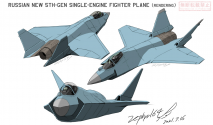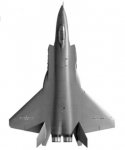There has long been a rumor of a stealthy dedicated strike bomber, JH-XX, under development. My hunch is if that rumor has basis in fact, then the need for a strike variant of the J-20 would be much less pressing.
You are using an out of date browser. It may not display this or other websites correctly.
You should upgrade or use an alternative browser.
You should upgrade or use an alternative browser.
J-20 5th Generation Fighter VII
- Thread starter siegecrossbow
- Start date
- Status
- Not open for further replies.
Looking at Russia's new fighter is it possible to design J-20 without the canards?
View attachment 74807
View attachment 74809
In the sense that it would basically be a new aircraft, sure, of course it's possible.
Why they would want to do that is another matter, because they went with the canard delta configuration for a reason, and it's now 2021 and work would be underway for a clean sheet 6th generation design rather than spending money on such a configuration that offers little significant benefit despite using aerospace resources, time and money.
It looks like the Boeing Yf-32, but much less ugly.Looking at Russia's new fighter is it possible to design J-20 without the canards?
View attachment 74807
Looking at Russia's new fighter is it possible to design J-20 without the canards?
In the sense that it would basically be a new aircraft, sure, of course it's possible.
Why they would want to do that is another matter, because they went with the canard delta configuration for a reason, and it's now 2021 and work would be underway for a clean sheet 6th generation design rather than spending money on such a configuration that offers little significant benefit despite using aerospace resources, time and money.
J-20 without canards would be possibly even more complex than a clean sheet design. No military aircraft has ever been properly considered for such major changes because it just doesn't work like that. Even stretching airliners (far larger budgets involved) take many years, up to decades and just to accommodate a seemingly simple re-balancing.
6th gen project/s will be underpinned by propulsion technology improving in ways that 5th gen engines simply will not suffice. They'll also obviously involve more networking capabilities and the expected digital improvements with the airframe and all components including manufacturing, be designed around those. Without engine breakthroughs, China's 6th gen is not close to flying. The US will probably be going for range and flight versatility for theirs and it's quite likely that China and Russia will both be bringing variable cycle into the mix as the foundation of 6th gen. Russia's Izd. 30 is supposed to be variable cycle if I recall correctly. China's program has long been hinted on but we've no idea how far along it is compared to the Russians and Americans.
The other aspects of 6th gen, China is and would be on top of. Propulsion if anything would be the department holding it back for China. Variable geometry (as the only other mechanical factor) that may become a hallmark feature for 6th gen, is also something China would not struggle with as much as propulsion. All of these are far more important than thinking about how to modify J-20 which was designed from the start to be the way it is rather than adding and removing certain aspects. One wouldn't remove the F-22's horizontal stabilisers either. At most mods would involve new sensors, weapons integration, and of course software + computing hardware.
Last edited:
J-20 without canards would be possibly even more complex than a clean sheet design. No military aircraft has ever been properly considered for such major changes because it just doesn't work like that. Even stretching airliners (far larger budgets involved) take many years, up to decades and just to accommodate a seemingly simple re-balancing.
6th gen project/s will be underpinned by propulsion technology improving in ways that 5th gen engines simply will not suffice. They'll also obviously involve more networking capabilities and the expected digital improvements with the airframe and all components including manufacturing, be designed around those. Without engine breakthroughs and even identifying what areas they will be in, 6th gen is not close to even flying. The US will probably be going for range and flight versatility for theirs and it's quite likely that China and Russia will both be bringing variable cycle into the mix as the foundation of 6th gen. Russia's Izd. 30 is supposed to be variable cycle if I recall correctly. China's program has long been hinted on but we've no idea how far along it is compared to the Russians and Americans.
The other aspects of future gen China is and would be on top of. Propulsion if anything would be the department holding it back for China. Variable geometry (as the only other mechanical factor) that may become a hallmark feature for 6th gen, is also something China would not struggle with as much as propulsion. All of these are far more important than thinking about how to modify J-20 which was designed from the start to be the way it is rather than adding and removing certain aspects. One wouldn't remove the F-22's horizontal stabilisers either. At most mods would involve new sensors, weapons integration, and of course software + computing hardware.
So, there's a reason why I kept my answer brief, because I didn't want to entertain his question too much and end up talking in too much depth about other topics which would risk having us become off topic in this thread.
It doesn't help that his depiction is unclear if it's meant to represent literally removing the canards and keeping the rest of the aircraft the same, or if it was just for simplicity of depiction and it was instead meant to represent removing the canards and increasing the size of the wing to say, a delta wing or something.
Either way, the simple answer to his question is this:
1. Yes, it is "possible" in the sense that if you throw enough aerospace resources, money, and time, that it can be "possible". This applies for both versions of his above question.
2. But it almost certainly will be pursued, because the benefits of such a change would be questionable to nothing, and not an efficient use of aerospace resources, money and time, which will be much better off spent on other projects, including but not limited clean sheet 6th generation designs.
I don't really think there's anything more to say than this.
Please take the hint here -- the purpose of this reply is to close off his question and close off the various openings to off topic discussions.
(I.e.: no detailed discussion or elaboration on what 6th generation aircraft could look like, or what other nations 6th gen efforts may look like, or the principles of how propulsion could influence 6th gen. It's inconsequential to the overall point which is that spending aerospace resources/time/money on his idea would not be a wise use of them)
…….J-20 without canards would be possibly even more complex than a clean sheet design. No military aircraft has ever been properly considered for such major changes because it just doesn't work like that……
That is not entirely true. See the the transformation between the standard F-16 and F-16XL. A transformation of the conventional F-22 into a completely tailless delta - even the vertical tails are gone - F/B-22 was also seriously proposed by Lockheed martin to produce a strike aircraft based on the F-22. F/B-22 would nonetheless retain 75% commonality with F-22, but offer 3 times more combat radius and several times more internal air-to-ground ordinance carrying capacity. A layout transformation of the J-20 on the similar scale would seem not to be technically impossible.
Last edited:
That is not entirely true. See the the transformation between the standard F-16 and F-16XL. A transformation of the conventional F-22 into a completely tailless delta - even the vertical tails are gone - F/B-22 was also seriously proposed by Lockheed martin to produce a strike aircraft based on the F-22. F/B-22 would nonetheless retain 75% commonality with F-22, but offer 3 times more combat radius and several times more internal air-to-ground ordinance carrying capacity. A layout transformation of the J-20 on the similar scale would seem not to be technically impossible.
Fair enough for the F-16XL on principle. But remember that the US in that era were full of these projects. They were research and experimental based and they've had dozens of all sorts just in disclosed programs. I don't doubt that if the engineers and directors considered a J-20 experimental program to be worthwhile, similar projects would run, albeit almost definitely in secrecy since China is the one behind while the US then had no peers that could even approach those program technicals and costs!
The F-16XL doesn't mean China would do something similar for the J-20 - playing and experimenting with it. It costs a lot of time and money for producing results that are probably more easily modeled using modern supercomputers and wind tunnels. The big spending of 1980s to 2000s US isn't a reflection of options for others. F/B/A-22 was a 2D ppt project even if groundwork and prelim analysis allowed for a worthwhile resulting aircraft. This doesn't mean J-20 would be considered for grand modification with the aim of introducing a drastically different aircraft.
All the F-16 and F-15 experimentals were done for testing some piece(s) of technology that weren't satisified by computing and wind tunneling. They also enjoyed a peerless status and had plenty of funds to burn through with no fear of those actions costing them any lead, if anything it was the time to experiment and discover more while they were so far ahead. They didn't have anyone remotely close and the academic and political attitude would have been quite different to today's environment of greater frugality and efficiency. Small scale one offs featuring grand modifications doesn't mean CAC and PLAAF would bother with doing something similar. To have a chance for the PLAAF's hardware to catch up in capability and the overall industry to catch up, China has to achieve results while running on greater frugality and efficiency since it has less wealth and is behind the US in military aviation technology. So unless there is actually a PLAAF requirement for something a drastically different J-20 could fill, it wouldn't even be bothered with. Academic lessons may or may not be worth the cost.
Okay lol, it seems my hint wasn't obvious enough.
Further discussion about the aerodynamics, rationale and benefits/costs of non-expected J-20 variants will not be allowed for this thread, and better continued in the aerodynamics thread. Any other posts on the matter will be deleted.
Further discussion about the aerodynamics, rationale and benefits/costs of non-expected J-20 variants will not be allowed for this thread, and better continued in the aerodynamics thread. Any other posts on the matter will be deleted.

Article excerpt in PLA Newspaper mentioning that a squadron from the first brigade (from Anshan) has equipped new combat aircraft (obviously J-20). They are already doing high difficulty training regimes but haven’t achieved systemic combat capability yet.
I suspect that not the whole squadron hasn’t made the transition yet.
- Status
- Not open for further replies.


